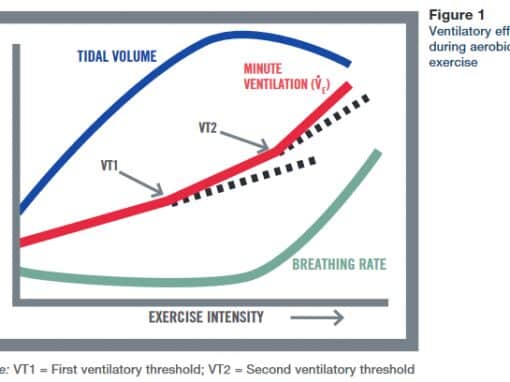Part 1: An Introduction to Metabolic Testing
In the first article of our Introductory Series, we examine VO2 max and ventilatory thresholds and discuss how this information can provide important insight into one's cardiorespiratory fitness.

Welcome to the first article of our Introductory Series. If you’re new to metabolic analysis or need a refresher on the subject, then this series is for you. On the other hand, if you’re advanced in the field of VO2 analysis, then we encourage you to please stay tuned for our Advanced Series of articles.
If you’re a professional coach, serious athlete or exercise scientist, you’re probably looking at and evaluating ways to run faster and farther, workout harder and push athletic limits.
Your investigation may include tracking such parameters as heart rate, caloric burn and top speed; however, there’s key fitness markers that your fitness watch can’t accurately tell you: your VO2max and ventilatory thresholds (VT1 and VT2). These parameters are useful physiological measures within the field of metabolic testing.
Your VO2 max and ventilatory thresholds can provide you with important insights about your cardiorespiratory fitness, such as how long you can sustain a certain intensity of exercise – which, for example, directly relates to your mile run time.
What is VO2max?
Let’s start with VO2max and then discuss ventilatory thresholds.
VO2max is an abbreviated term for maximal oxygen consumption, which refers to the maximum amount of oxygen that an individual can utilize during intense or maximal exercise.
It’s measured in millilitres of oxygen per kilogram of body weight per minutes (ml/kg/min) with essentially two determining factors:
- How much blood your heart can pump out to the muscles with each beat (cardiac output).
- How efficiently your muscles can extract the oxygen from the blood and utilize it.
This measurement is generally considered the best indicator of cardiovascular fitness and aerobic endurance. The more oxygen a person can use during high level exercise, the more energy a person can produce.
As such, this test is the gold standard for determining cardiorespiratory fitness because muscles need oxygen for prolonged aerobic exercise, and the heart must pump adequate amounts of blood through the circulation to meet the demands of aerobic exercise.
The bottom line is the higher your VO2max score, the more aerobic potential you have.
However, with the right training, you can increase your VO2max. And perhaps more importantly, you’ll be able to increase your efficiency at higher outputs of speed and power.
How do you test VO2max?
By putting a face mask on the person being tested (the subject), it’s possible to directly measure the volume and gas concentrations of inspired and expired air. This breath-by-breath measurement is agreed upon by researchers as being the most accurate way to conduct VO2 analysis.
The test involves exercising (often running or bicycling) at an intensity that increases every few minutes until exhaustion and is designed to achieve a maximal effort.
During this test, the individual’s maximum heart rate is also determined which, along with resting heart rate, can be used to develop a more precise target heart rate ranges. This is more accurate than age-predicted equations.
As a result of this process, clear insight into the subject’s current fitness level is ascertained along with information as to how to most efficiently improve their fitness level.
Up until recently, obtaining an accurate measure of one’s VO2max wasn’t easy – you needed to measure it in a lab with expensive clinical medical equipment. Thankfully, that’s all changed now with the advent of the innovative VO2 Master Analyzer.
Training Intensities
Before we move on to discussing ventilatory thresholds, it’s necessary to cover training intensities.
Ventilation and heart rate serve as a good reference points for determining one’s training intensity and, unlike power or speed, these measures show how intense the effort is on the body. The higher the value for each, the more stress is being placed on the body.
Training Zones
VO2 Master has defined five training zones defined by breathing rate and heart rate that categorize intensity levels.
• Zone 1: Rest
Zone 1 is the lowest intensity level where a person is at rest. At this level, heart rate is low and breathing rate may be somewhat irregular due to one shifting, yawning and slight movements.
• Zone 2: Mild
In this zone a person is moving, and may be walking, jogging or cycling at an easy pace. Here, heart rate begins to increase and breathing rate becomes very steady. A person can easily converse with others in this stage.
• Zone 3: Moderate
This zone is characterized by more effort and may include running or cycling at a relatively comfortable pace. Heart rate continues to increase in a linear fashion and breathing rate continues to be regular; however, the tidal volume has increased (the volume of air inhaled and exhaled per breath).
• Zone 4: Heavy
In this zone, a person is exercising at an intensity where they are breathing hard and are limited as to how long they can continue to move at this level. Lactate starts to climb, and the athlete is beginning to lose control of their breathing, as their breathing rate now increases significantly – a departure from the regular intervals of Zones 2 & 3. Heartrate continues to climb at a uniform level commensurate with applied exercise effort.
• Zone 5: Maximum
The topmost zone is where a subject loses control of their breathing entirely, with their breathing rate skyrocketing. They will only be able to stay in this stage for a short period of time – up to 2 minutes. Heart rate will hit its maximum as the person tries to hang on, before inevitably dropping out of this level of intensity.
Ventilatory Threshold Testing
Now that we have defined the five intensity training zones, we can look to two points of interest, around which training zones are organized for an individual – ventilatory thresholds.
Ventilatory threshold testing is based on the physiological principle of ventilation. During lower stages of exercise intensity (Zones 2 & 3), ventilation increases linearly with oxygen consumption and carbon dioxide production. This occurs primarily through an increase in tidal volume.
At higher intensities (Zones 4 & 5), the frequency of breathing becomes more pronounced and minute ventilation (measured as the volume of air breathed per minute) rises disproportionally to the increase in oxygen consumption. This means that persons at these higher levels begin to breathe more rapidly with each breath consuming less oxygen.
As exercise intensity increases, ventilation increases in a somewhat linear fashion. Now, there two deflection points at certain intensities associated with the metabolic changes occurring within the body.
The first point – Ventilatory Threshold 1 (or VT1) – is called the “crossover” point and occurs between Zone 3 and Zone 4.

This point is where blood lactate accumulates faster than it can be cleared, which causes a person to breathe faster in order to blow off the extra CO2 produced by the buffering of acid metabolites. Prior to this intensity, fats are the major source of fuel and only small amounts of lactate are being produced.
The need for additional oxygen here is met primarily through an increase in tidal volume and not by breathing faster. In other words, at this point, a person’s breathing rate remains steady – they just take in more oxygen per breath.
Past the crossover point (VT1), ventilation rates will begin to increase exponentially as oxygen demands outpace the oxygen-delivery system and lactate begins to accumulate in the blood.
Eventually, the person will approach the second disproportionate increase in ventilation – the second Ventilatory Threshold 2 (VT2) – which occurs between Zones 4 & 5 at the point where lactate is increasing with intensity, representing hyperventilation. This is the point where blowing off CO2 is no longer adequate to buffer the increase in acidity that is occurring with progressively intense exercise.
The VT1 to VT2 Distance
The longer a person can stay in the stretch between VT1 and VT2, the more energy and aerobic potential they will possess.
The good news is that it’s possible to extend one’s distance between VT1 and VT2 such that a person can work at higher intensities before hitting the second ventilatory threshold. This capability can be established through an optimal mix of low and high intensity training. But how do you determine what that mix should ideally be for a particular athlete?

Why Metabolic Testing is Important
As mentioned above, VO2max, VT1 and VT2 scores are physiological measures that are a part of metabolic testing, which can be performed with the VO2 Master Analyzer.
Being aware of these values can provide a useful way of optimizing the design, intensity and effectiveness of your training sessions.
Without this insight, many athletes will spend too long training at high intensities, which results in inhibited aerobic fitness gains and more susceptibility to injury.
But, with accurate VO2 analysis, players and their coaches can strategically construct training regimens that are designed to produce optimal gains in cardiovascular fitness. These training plans will specify – on an individual basis – the ideal types of training and intensities an athlete should undertake to achieve desired results. In other words, they will know exactly which training zones they need to be in at any given time.
In fact, when athletes discover how they should be ideally training, many are at first shocked by how much slower they need to run or cycle in order to stick to their optimal training zones.
With smarter training procedures, it doesn’t take long to begin to see the substantial value of regular VO2 analysis: more energy while competing and quicker and more effective recovery, which translates to improved overall performance.
For example, an Olympic athlete equipped with the information as to how to train more effectively than her competitors has a distinct advantage when it comes time to compete for gold.
—
In our next article of the VO2 Master Introductory Series, we will explore how oxygen is utilized by the body and dig deeper into applying VT1, VT2 and VO2max values in developing optimal fitness training programs.
